tire pressure TESLA ROADSTER 2008 Owners Manual
[x] Cancel search | Manufacturer: TESLA, Model Year: 2008, Model line: ROADSTER, Model: TESLA ROADSTER 2008Pages: 115, PDF Size: 46.35 MB
Page 42 of 115
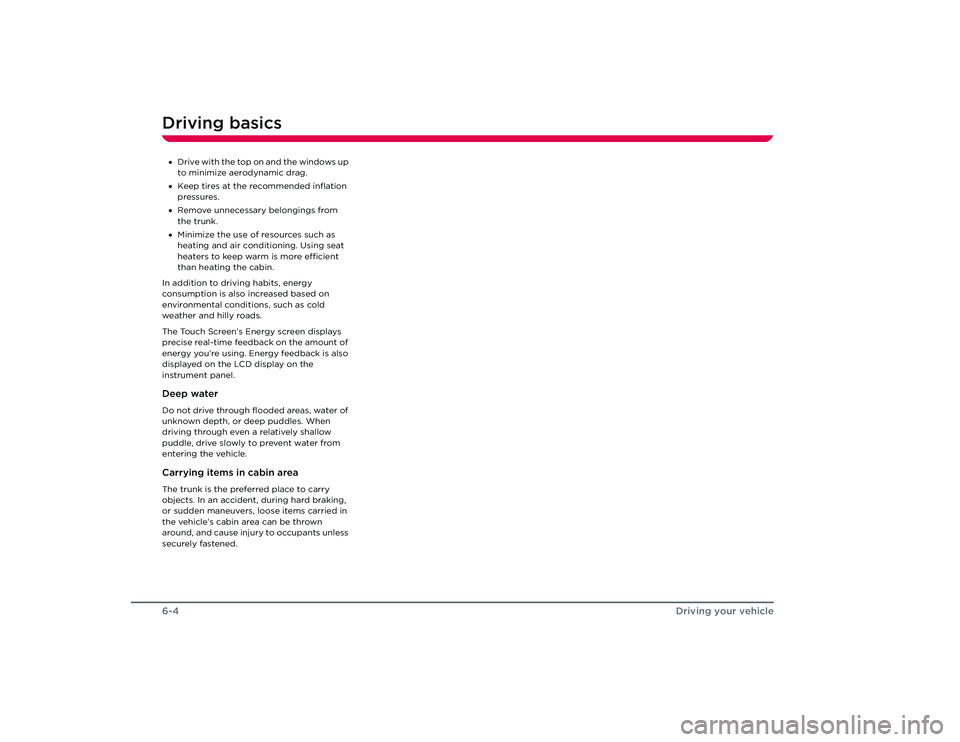
Driving basics6-4
Driving your vehicle
•Drive with the top on and the windows up
to minimize aerodynamic drag.
• Keep tires at the recommended inflation
pressures.
• Remove unnecessary belongings from
the trunk.
• Minimize the use of resources such as
heating and air conditioning. Using seat
heaters to keep warm is more efficient
than heating the cabin.
In addition to driv ing habits, energy
consumption is also increased based on
environmental conditions, such as cold
weather and hilly roads.
The Touch Screen’s Energy screen displays
precise real-time feedback on the amount of
energy you’re using. Energy feedback is also
displayed on the LCD display on the
instrument panel. Deep waterDo not drive through flooded areas, water of
unknown depth, or deep puddles. When
driving through even a relatively shallow
puddle, drive slowly to prevent water from
entering the vehicle. Carrying items in cabin areaThe trunk is the preferred place to carry
objects. In an accident, during hard braking,
or sudden maneuvers, loose items carried in
the vehicle’s cabin area can be thrown
around, and cause injury to occupants unless
securely fastened.Roadster OHB.book Page 4 Th ursday, October 2, 2008 8:59 AM
Page 51 of 115

Instruments
6-13
Driving your vehicle
Charge indicator. Flashes amber when
the vehicle is charging.
Charge indicator. Illuminates red when
the charging port door is open and
the vehicle is not charging.
Caution: Never run the vehicle until the
Battery is fully depleted. If the Battery
is fully depleted, all electrical systems on the
vehicle are inoperable and the vehicle can not
be driven.
Tire pressure indicator. Illuminates
when the pressure of a tire is out of
range. If a fault with the Tire Pressure
Monitoring System (TPMS) is detected, the
warning indicator flas hes. Check the Touch
Screen for more information.
Seat belt warning. Illuminates
whenever the driver’s seat belt is
unbuckled and the starter switch is in the ON
position. Also, an audible sound will be heard
for six seconds if the starter switch is turned
to the ON position and the drivers seat belt is
unbuckled. If the car is driven more than a
tenth of a mile with the driver’s seat belt
unbuckled, you’ll hear a warning tone.
Airbag warning. Illu minates during the
system check that occurs when the
starter switch is turned to the ON position.
This indicator should extinguish within
approximately six seconds. If the light fails to
illuminate, or fails to extinguish after six
seconds, a fault has occurred and you must
contact Tesla Motors. Warning: If the airbag indicator is
illuminated, the airbag system will be
deactivated. Contact Tesla Motors
immediately. In the event of an accident the
airbags may not inflate.
�S
Non-critical fault. Illuminates yellow
when a non-critical fault is detected.
For example, when power is reduced due to
high temperature. Bring the vehicle to Tesla
Motors for servicing as soon as possible.
Critical fault. Illuminates red when a
critical fault is detected. This is usually
accompanied by the inability to drive the
vehicle and a shutdown of all electrical
systems. Stop the vehicle as soon as it is safe
to do so, and contact Tesla Motors.
Traction control. Illuminates when the
traction control has been manually
deactivated and will il luminate briefly in
situations where traction control is in use.
Cruise control. Illuminates when the
cruise control system is operating.
Frost warning. Illuminates when the
temperature outside the vehicle falls
below 37º F (3º C). Extinguishes when the
temperature raises again to
exceed 41º F (5º C).
Gear position indicatorsWhen the starter switch is turned to the ON
position, the gear po sition indicators
sequentially (and briefly) illuminate red and then green. When the start-up sequence is
complete, the indicator corresponding to the
currently selected gear (
N) remains
illuminated green. For more information, see
Selecting gears, page 6-3 .FAULTFAULTTCCRUISEPRND
Roadster OHB.book Page 13 Thursday, October 2, 2008 8:59 AM
Page 70 of 115
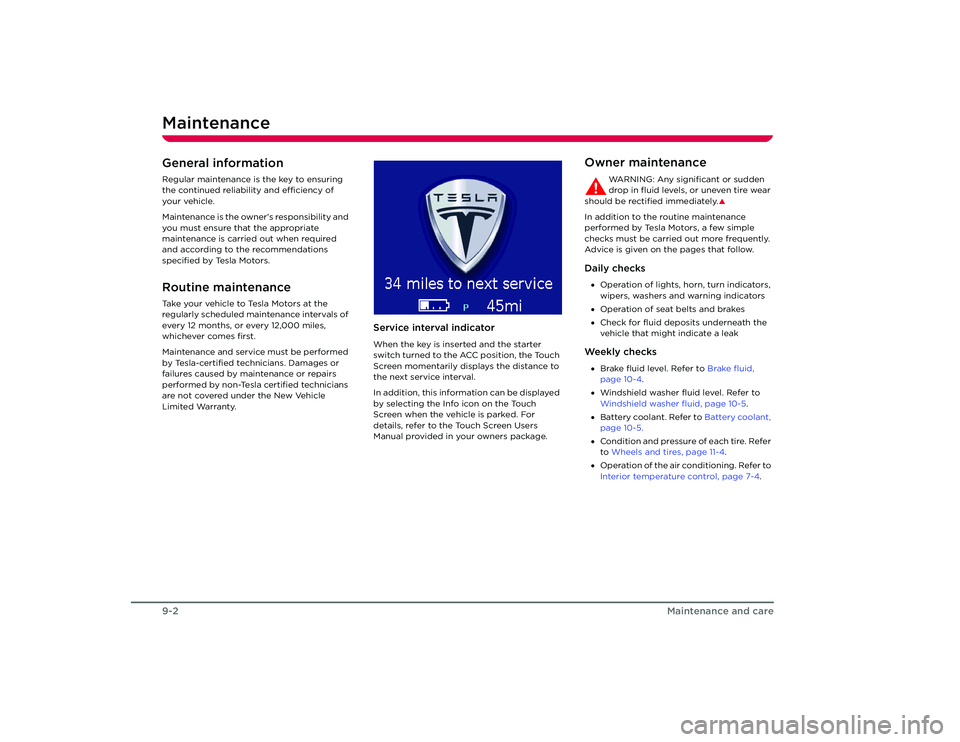
Maintenance9-2
Maintenance and care
Maintenance and care
MaintenanceGeneral informationRegular maintenance is the key to ensuring
the continued reliability and efficiency of
your vehicle.
Maintenance is the owner's responsibility and
you must ensure that the appropriate
maintenance is carried out when required
and according to the recommendations
specified by Tesla Motors.Routine maintenanceTake your vehicle to Tesla Motors at the
regularly scheduled maintenance intervals of
every 12 months, or every 12,000 miles,
whichever comes first.
Maintenance and service must be performed
by Tesla-certified technicians. Damages or
failures caused by maintenance or repairs
performed by non-Tesla certified technicians
are not covered under the New Vehicle
Limited Warranty.
Service interval indicatorWhen the key is inserted and the starter
switch turned to the ACC position, the Touch
Screen momentarily displays the distance to
the next service interval.
In addition, this information can be displayed
by selecting the Info icon on the Touch
Screen when the vehicle is parked. For
details, refer to the Touch Screen Users
Manual provided in your owners package.
Owner maintenance
WARNING: Any significant or sudden
drop in fluid levels, or uneven tire wear
should be rectified immediately.
�S
In addition to the routine maintenance
performed by Tesla Motors, a few simple
checks must be carried out more frequently.
Advice is given on the pages that follow.Daily checks• Operation of lights, horn, turn indicators,
wipers, washers and warning indicators
• Operation of seat belts and brakes
• Check for fluid deposits underneath the
vehicle that might indicate a leakWe e k l y c h e c k s•Brake fluid level. Refer to Brake fluid,
page 10-4 .
• Windshield washer fluid level. Refer to
Windshield washer fluid, page 10-5 .
• Battery coolant. Refer to Battery coolant,
page 10-5.
• Condition and pressure of each tire. Refer
to Wheels and tires, page 11-4 .
• Operation of the air conditioning. Refer to
Interior temperature control, page 7-4.
Roadster OHB.book Page 2 Th ursday, October 2, 2008 8:59 AM
Page 81 of 115
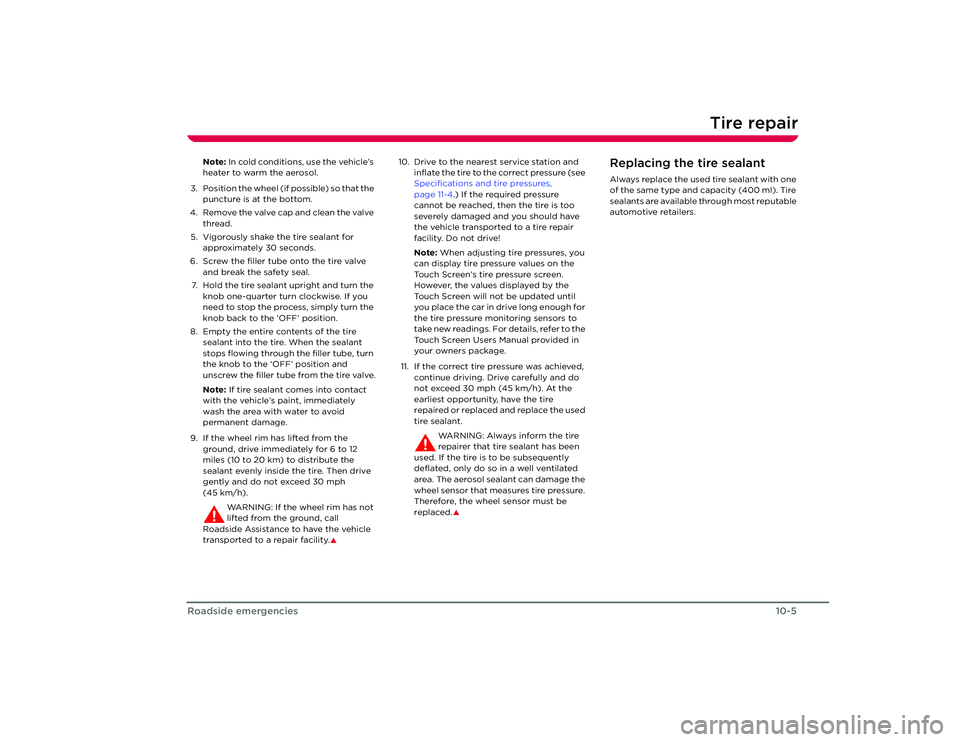
Tire repair
10-5
Roadside emergencies
Note: In cold conditions, use the vehicle’s
heater to warm the aerosol.
3. Position the wheel (if possible) so that the puncture is at the bottom.
4. Remove the valve cap and clean the valve thread.
5. Vigorously shake the tire sealant for approximately 30 seconds.
6. Screw the filler tube onto the tire valve and break the safety seal.
7. Hold the tire sealant upright and turn the knob one-quarter turn clockwise. If you
need to stop the process, simply turn the
knob back to the ‘OFF’ position.
8. Empty the entire contents of the tire sealant into the tire. When the sealant
stops flowing through the filler tube, turn
the knob to the ‘OFF’ position and
unscrew the filler tube from the tire valve.
Note: If tire sealant comes into contact
with the vehicle’s paint, immediately
wash the area with water to avoid
permanent damage.
9. If the wheel rim has lifted from the ground, drive immediately for 6 to 12
miles (10 to 20 km) to distribute the
sealant evenly inside the tire. Then drive
gently and do not exceed 30 mph
(45 km/h).
WARNING: If the wheel rim has not
lifted from the ground, call
Roadside Assistance to have the vehicle
transported to a repair facility.
�S
10. Drive to the nearest service station and inflate the tire to the correct pressure (see
Specifications and tire pressures,
page 11-4 .) If the required pressure
cannot be reached, then the tire is too
severely damaged and you should have
the vehicle transported to a tire repair
facility. Do not drive!
Note: When adjusting tire pressures, you
can display tire pressure values on the
Touch Screen’s tire pressure screen.
However, the values displayed by the
Touch Screen will not be updated until
you place the car in drive long enough for
the tire pressure monitoring sensors to
take new readings. For details, refer to the
Touch Screen Users Manual provided in
your owners package.
11. If the correct tire pressure was achieved, continue driving. Drive carefully and do
not exceed 30 mph (45 km/h). At the
earliest opportunity, have the tire
repaired or replaced and replace the used
tire sealant.
WARNING: Always inform the tire
repairer that tire sealant has been
used. If the tire is to be subsequently
deflated, only do so in a well ventilated
area. The aerosol sealant can damage the
wheel sensor that measures tire pressure.
Therefore, the wheel sensor must be
replaced.
�S
Replacing the tire sealantAlways replace the used tire sealant with one
of the same type and capacity (400 ml). Tire
sealants are available through most reputable
automotive retailers.
Roadster OHB.book Page 5 Th ursday, October 2, 2008 8:59 AM
Page 91 of 115
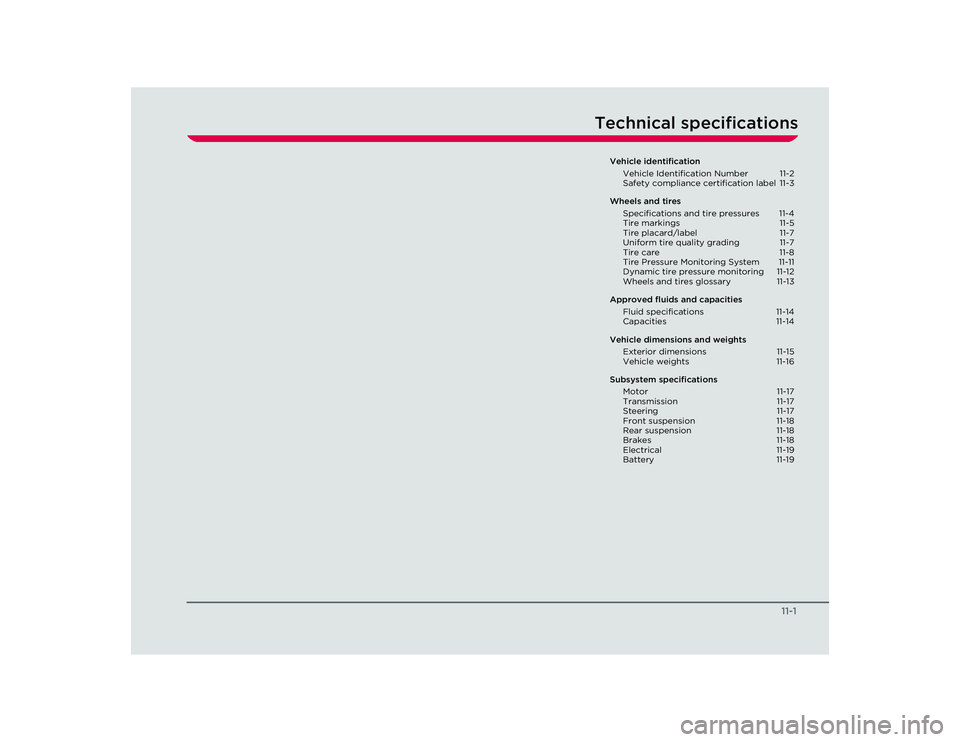
11-1
Technical specifications
Vehicle identificationVehicle Identification Number 11-2
Safety compliance certification label 1 1-3
Wheels and tires Specifications and tire pressures 11-4
Tire markings 11-5
Tire placard/label 11-7
Uniform tire quality grading 11-7
Tire care 11-8
Tire Pressure Monitoring System 11 -11
Dynamic tire pressure monitoring 11-12
Wheels and tires glossary 11-13
Approved fluids and capacities Fluid specifications 11-14
Capacities 11-14
Vehicle dimensions and weights Exterior dimensions 11-15
Vehicle weights 11-16
Subsystem specifications Motor 11-17
Transmission 11-17
Steering 11-17
Front suspension 11-18
Rear suspension 11-18
Brakes 11-18
Electrical 11-19
Battery 11-19
Roadster OHB.book Page 1 Thursday, October 2, 2008 8:59 AM
Page 94 of 115

Wheels and tires11-4
Technical specifications
Wheels and tiresSpecifications and tire
pressuresWheel type
Location
Size
Forged light alloy - directional Front 6J x 16 Rear7.5J x 17
Tire type
Location
Size
Yokohama Neova AD07 LTS - directional Front 175/55 R16 Rear225/45 R17
Road wheel bolt torque 77 lbf.ft 105 Nm
Note: For details on where to position a jack to lift the vehicle, see Vehicle jacking points, page 10-11.Tire
Tire Pressure
Recommended
Comfort setting
Front 30 PSI (207 kPa)25 PSI (172 kPa)
Rear 40 PSI (276 kPa)36 PSI (248 KPa)
Note: The recommended tire pressures have been calculated to provide the best combination of vehicle range, tire life, ride comfort a nd road
handling.
Driving the vehicle with the tires inflated to the comfort setti ng will improve ride comfort and road handling, but will decrea se vehicle range (the
number of miles you can travel on a charge) and Battery life (see the New Vehicle Limited Warranty, provided in your owners pac kage, for details
on expected range of the Battery).
Roadster OHB.book Page 4 Th ursday, October 2, 2008 8:59 AM
Page 96 of 115

Wheels and tires11-6Technical specifications7, U.S DOT Tire Identification Number
(TIN)This begins with the letters DOT and
indicates that the tire meets all federal
standards. The next two numbers or letters
are the plant code where it was
manufactured, and the last four numbers
represent the week and year the tire was
built. For example, the numbers 1706 means
the 17th week of 2006. The other numbers
are marketing codes used at the
manufacturer's discretion. This information
can be used to contact consumers if a tire
defect requires a recall.8, Maximum permissible inflation
pressureThe maximum inflation pressure for the tire.
This pressure should not be used for normal
driving.
9, Treadwear gradeThis number indicates the tire's wear rate.
The higher the treadwear number is, the
longer it should take for the tread to wear
down. A tire rated at 400 for example, will
last twice as long as a tire rated at 200.10, Traction gradeThis letter indicates a tire's ability to stop on
wet pavement. A higher graded tire should
allow you to stop your vehicle on wet roads in
a shorter distance than a tire with a lower
grade.
Traction is graded from highest to lowest as
AA, A, B, and C.11, Temperature gradeHeat resistance grading. The tires resistance
to heat is grade A, B, or C, with A indicating
the greatest resistance to heat. This grading
is provided for a correctly inflated tire, which
is being used within its speed and loading
limits.12, Tire composition and materialsThe number of plies in both the tread area,
and the sidewall area, indicates how many
l aye rs o f ru bb e r co ate d m ate ri al m ake u p t h e
structure of the tire. Information is also
provided on the type of materials used.
Rating
Speed (mph)
Q99 R106S 112
T 118
U124
H130 V149
W168 Y186
Roadster OHB.book Page 6 Th ursday, October 2, 2008 8:59 AM
Page 97 of 115
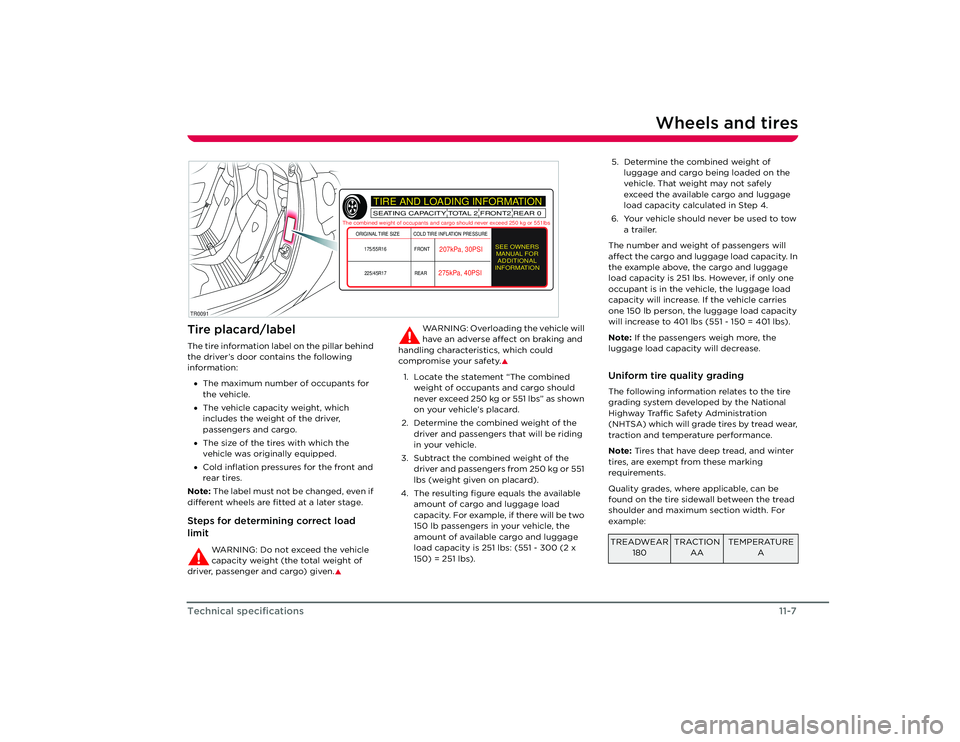
Wheels and tires
11-7
Technical specifications
Tire placard/labelThe tire information label on the pillar behind
the driver’s door contains the following
information:
• The maximum number of occupants for
the vehicle.
• The vehicle capacity weight, which
includes the weight of the driver,
passengers and cargo.
• The size of the tires with which the
vehicle was originally equipped.
• Cold inflation pressures for the front and
rear tires.
Note: The label must not be changed, even if
different wheels are fitted at a later stage.Steps for determining correct load
limit
WARNING: Do not exceed the vehicle
capacity weight (the total weight of
driver, passenger and cargo) given.
�S
WARNING: Overloading the vehicle will
have an adverse affect on braking and
handling characteristics, which could
compromise your safety.
�S
1. Locate the statement “The combined weight of occupants and cargo should
neve r exce e d 2 50 kg or 5 51 l bs ” as s h ow n
on your vehicle’s placard.
2. Determine the combined weight of the driver and passengers that will be riding
in your vehicle.
3. Subtract the combined weight of the driver and passengers from 250 kg or 551
lbs (weight given on placard).
4. The resulting figure equals the available amount of cargo and luggage load
capacity. For example, if there will be two
150 lb passengers in your vehicle, the
amount of available cargo and luggage
load capacity is 251 lbs: (551 - 300 (2 x
150) = 251 lbs).
TR0091
TIRE AND LOADING INFORMATIONSEATING CAPACITY TOTAL 2 FRONT2 REAR 0
SEE OWNERSMANUAL FOR ADDITIONAL
INFORMATION
The combined weight of occupants and cargo should never exceed 250 kg or 551lbs
ORIGINAL TIRE SIZE
COLD TIRE INFLATION PRESSURE
175/55R16
225/45R17 FRONT
REAR
207kPa, 30PSI
275kPa, 40PSI
5. Determine the combined weight of luggage and cargo being loaded on the
vehicle. That weight may not safely
exceed the available cargo and luggage
load capacity calculated in Step 4.
6. Your vehicle should never be used to tow a trailer.
The number and weight of passengers will
affect the cargo and luggage load capacity. In
the example above, the cargo and luggage
load capacity is 251 lbs. However, if only one
occupant is in the vehicle, the luggage load
capacity will increase. If the vehicle carries
one 150 lb person, the luggage load capacity
will increase to 401 lbs (551 - 150 = 401 lbs).
Note: If the passengers weigh more, the
luggage load capacity will decrease.Uniform tire quality gradingThe following information relates to the tire
grading system developed by the National
Highway Traffic Safety Administration
(NHTSA) which will grade tires by tread wear,
traction and temperature performance.
Note: Tires that have deep tread, and winter
tires, are exempt from these marking
requirements.
Quality grades, where applicable, can be
found on the tire sidewall between the tread
shoulder and maximum section width. For
example:TREADWEAR 180
TRACTION AA
TEMPERATURE A
Roadster OHB.book Page 7 Th ursday, October 2, 2008 8:59 AM
Page 98 of 115

Wheels and tires11-8Technical specificationsIn addition to the marking requirements,
passenger car tires must conform to Federal
Safety Requirements.
Note: Your vehicle is equipped with
directional tires. Therefore, you can see the
tire markings only on the outside of the
passenger tires. TreadwearThe treadwear grade is a comparative rating
based on the wear rate of the tire when
tested under controlled conditions on a
specified government test course.
For example; a tire graded 150 would wear
one and a half times as well on a government
test course as a tire graded 100. The relative
performance of tires depends on the actual
conditions of their use, however, and may
depart significantly from the norm due to
variations in driving habits, service practices,
and differences in road characteristics and
climate.Tra c t i o n
WARNING: The traction grade assigned
to this tire is based on straight-ahead
braking tests, and does not include;
acceleration, cornering, hydroplaning or peak
traction characteristics.
�S
The traction grades, from highest to lowest,
are; AA, A, B, and C. These grades represent
a tire’s ability to stop on a wet pavement as
measured under controlled conditions on
specified government test surfaces of asphalt
and concrete. A tire marked C may have poor
traction performance.
Te m p e r a t u r e
WARNING: The temperature grade for
this tire is established for a tire that is
properly inflated and not overloaded.
Excessive speed, under-inflation, or excessive
loading, either separately or in combination,
can cause heat buildup and possible tire
failure.�S
The temperature grades are A (the highest),
B, and C, representing the tire's resistance to
the generation of heat and its ability to
dissipate heat when tested under controlled
conditions on a specified indoor laboratory
test wheel.
Sustained high temperature can cause the
material of the tire to degenerate and reduce
tire life, and excessive temperature can lead
to sudden tire failure.
The grade C corresponds to a level of
performance which all passenger car tires
must meet under the Federal Motor Safety
Standard No. 109.
Grades B and A represent higher levels of
performance on the laboratory test wheel
than the minimum required by law.Tire care
WARNING: Defective tires are
dangerous. Do not drive if any tire is
damaged, is excessively worn, or is inflated to
an incorrect pressure.
�S
Always consider tire conditions when driving,
and regularly inspect the tread and side walls
for any sign of distorti on (bulges), cuts or
wear.
The way you drive has a significant influence
on your safety and on the life of your tires.
Cultivate good habits for your own benefit:
• Observe posted speed limits.
• Avoid fast starts, stops and turns.
• Avoid potholes and objects in the road.
• Do not run over curbs or hit the tire
against the curb when parking.
Caution: Avoid contaminating tires with
vehicle fluids that can cause damage.Tire pressure information
WARNING: If the vehicle has been
parked in strong sunlight or used in high
ambient temperatures, do not reduce the tire
pressures. Move the vehicle into the shade and
allow the tires to cool before checking.
�S
Correctly inflated tires will ensure that you
enjoy the best combination of vehicle range,
tire life, ride comfort and road handling.
Tire pressure should be checked when the
tires are cold. Inflate each tire to the pressure
recommended by Tesla Motors on the vehicle
placard, or tire inflation pressure label.
As an added safety feature, your
vehicle has been equipped with a tire
pressure monitoring system (TPMS) that
illuminates a tire pressure telltale when one or
more of your tires is significantly
under-inflated. Accordingly, when the low tire
Roadster OHB.book Page 8 Th ursday, October 2, 2008 8:59 AM
Page 99 of 115
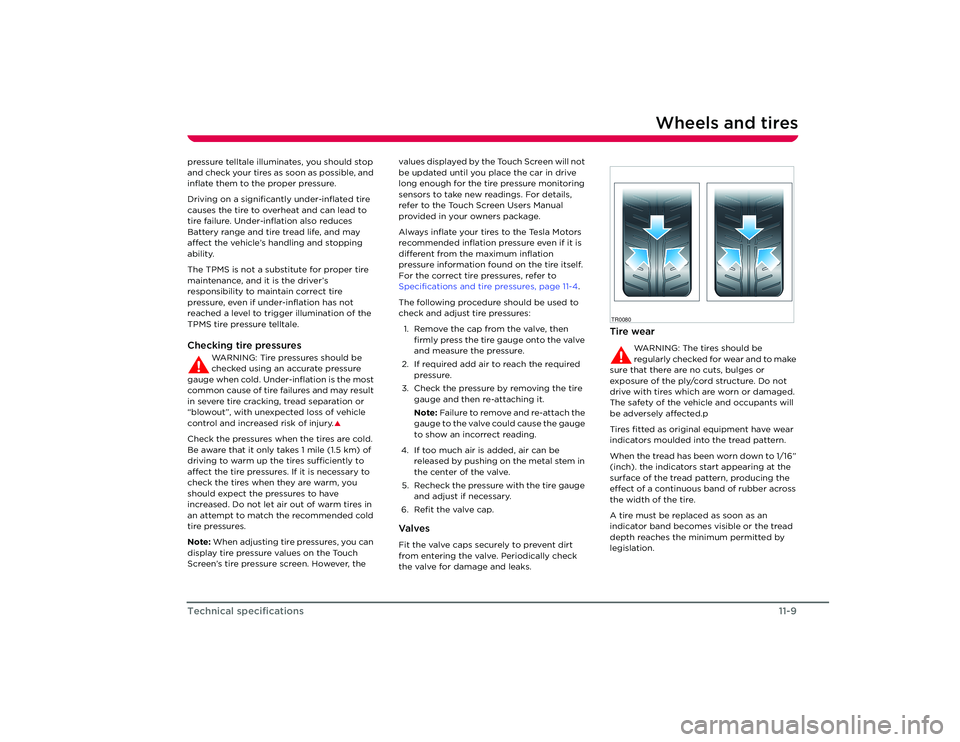
Wheels and tires
11-9
Technical specifications
pressure telltale illuminates, you should stop
and check your tires as soon as possible, and
inflate them to the proper pressure.
Driving on a significantly under-inflated tire
causes the tire to overheat and can lead to
tire failure. Under-inflation also reduces
Battery range and tire tread life, and may
affect the vehicle’s handling and stopping
ability.
The TPMS is not a substitute for proper tire
maintenance, and it is the driver’s
responsibility to maintain correct tire
pressure, even if under-inflation has not
reached a level to trigger illumination of the
TPMS tire pressure telltale.Checking tire pressures
WARNING: Tire pressures should be
checked using an accurate pressure
gauge when cold. Under-inflation is the most
common cause of tire failures and may result
in severe tire cracking, tread separation or
“blowout”, with unexpected loss of vehicle
control and increased risk of injury.
�S
Check the pressures when the tires are cold.
Be aware that it only takes 1 mile (1.5 km) of
driving to warm up the tires sufficiently to
affect the tire pressures. If it is necessary to
check the tires when they are warm, you
should expect the pressures to have
increased. Do not let air out of warm tires in
an attempt to match the recommended cold
tire pressures.
Note: When adjusting tire pressures, you can
display tire pressure values on the Touch
Screen’s tire pressure screen. However, the values displayed by the Touch Screen will not
be updated until you place the car in drive
long enough for the tire pressure monitoring
sensors to take new readings. For details,
refer to the Touch Screen Users Manual
provided in your owners package.
Always inflate your tires to the Tesla Motors
recommended inflation pressure even if it is
different from the maximum inflation
pressure information found on the tire itself.
For the correct tire pressures, refer to
Specifications and tire pressures, page 11-4
.
The following procedure should be used to
check and adjust tire pressures: 1. Remove the cap from the valve, then firmly press the tire gauge onto the valve
and measure the pressure.
2. If required add air to reach the required pressure.
3. Check the pressure by removing the tire gauge and then re-attaching it.
Note: Failure to remove and re-attach the
gauge to the valve could cause the gauge
to show an incorrect reading.
4. If too much air is added, air can be released by pushing on the metal stem in
the center of the valve.
5. Recheck the pressure with the tire gauge and adjust if necessary.
6. Refit the valve cap.
Va l ve sFit the valve caps securely to prevent dirt
from entering the valve. Periodically check
the valve for damage and leaks.
Tire wear
WARNING: The tires should be
regularly checked for wear and to make
sure that there are no cuts, bulges or
exposure of the ply/cord structure. Do not
drive with tires which are worn or damaged.
The safety of the vehicle and occupants will
be adversely affected.p
Tires fitted as original equipment have wear
indicators moulded into the tread pattern.
When the tread has been worn down to 1/16”
(inch). the indicators start appearing at the
surface of the tread pattern, producing the
effect of a continuous band of rubber across
the width of the tire.
A tire must be replaced as soon as an
indicator band becomes visible or the tread
depth reaches the minimum permitted by
legislation.
TR0080
Roadster OHB.book Page 9 Th ursday, October 2, 2008 8:59 AM